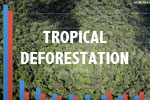
Change in vegetation cover by biome across Latin America, 2001-2010. Click image to enlarge.
Latin America lost nearly 260,000 square kilometers (100,000 square miles) of forest — an area larger than the state of Oregon — between 2001 and 2010, finds a new study [PDF] that is the first to assess both net forest loss and regrowth across the Caribbean, Central and South America.
The study, published in the journal Biotropica by researchers from the University of Puerto Rico and other institutions, analyzes change in vegetation cover across several biomes, including forests (dry, temperate, moist, mangroves and coniferous), grasslands (pampas, shrublands, montane grasslands, savanna, desert/xeric shrublands), and wetlands (pantanal). It finds that the bulk of vegetation change occurred in forest areas, mostly tropical rainforests and lesser-known dry forests. The largest gains in woody vegetation area occurred in desert vegetation and shrublands.
Gross deforestation amounted to 542,000 sq km, while recovery of woody vegetation occurred across 362,000 sq km.

The distribution of hotspots of deforestation and reforestation relative to the ten major biomes in Latin America and the Caribbean as proposed by Olson et al. (2001). Included in the legend are the original biome names, the names used in AIDE ET AL 2012, and the area of each biome based on municipality boundaries, as calculated for AIDE ET AL 2012. Each dot represents one of the 2513 municipalities that had a significant change in woody vegetation over the 10-yr period (2001–2010). Image and caption courtesy of AIDE ET AL 2012. Click image to enlarge.
Argentina experienced the largest net loss across all biomes, losing 101,734 square kilometers, mostly in the form of dry forests (67,140 sq km) and grasslands (15,729 sq km). Brazil followed with a loss of 99,424 sq km, primarily in the form of moist forests (145,511 sq km). Brazil had the highest gross loss of vegetation cover during the period (245,767 sq km), but that was partly offset by the highest gross gain (146,342 sq km).
Mexico had the largest net increase in biome area at 96,089 sq km mostly due to a rise in land classified as “desert/xeric shrub” cover (79,085) and regrowth of dry forests (12,810) and coniferous forest (11,907 sq km).
The study is based on assessment of NASA MODIS satellite data for some 16,000 municipalities across Latin America and the Caribbean. It excludes plantations and large-scale agricultural areas.

Change in forest cover across South America, 2001-2010. Click image to enlarge.

Change in forest cover across Central America, 2001-2010. Click image to enlarge.

Change in forest cover by across Caribbean Island nations, 2001-2010. Click image to enlarge.
Overall the paper found that 80 percent of deforestation occurred in just four countries — Brazil, Argentina, Paraguay, and Bolivia — and was most closely associated with export-oriented agriculture.
“A key factor contributing to deforestation in South America is the increasing global demand for meat products, which has intensified land clearing for grazing and large-scale agriculture,” said lead author Mitchell Aide of the University of Puerto Rico. “Beef exports have increased dramatically, and there has also been a boom in soybean production. These soybeans are not for tofu or soy milk, but pig and poultry feed in China and Europe.”
The study found forest recovery in regions that are too dry or steep for industrial agriculture, a result that is consistent with other recently published papers suggesting rural abandonment in some marginal areas and the growing displacement of small-holder deforestation by industrial forest clearing.
Increases in vegetation cover were particularly significant in the desert/xeric shrublands biome in northern Mexico and northeast Brazil.
“Although more detailed analyses are needed to better understand these trends, we believe that these gains in woody vegetation were associated with a decrease in agricultural or grazing activities, and increases in regional rainfall during the last decade,” said co-author Matthew Clark of Sonoma State University.
Latin America has the largest extent of forest cover of any region in the world.
CITATION: Aide, T. M., M. L. Clark, H. R. Grau, D. López-Carr, M. Levy, D. Redo, M. Bonilla-Moheno, G. Riner, M. J. Andrade-Núñez, and M. Muñiz. Online August 3, 2012. Deforestation and reforestation of Latin America and the Caribbean (2001-2010). Biotropica. DOI: 10.1111/j.1744-7429.2012.00908.x
Related articles
Charts: deforestation in Indonesia and Malaysia, 2000-2010

(07/15/2012) Indonesia and Malaysia lost more than 11 million hectares (42,470 square miles) of forest between 2000 and 2010, according to a study published last year in the journal Global Change Biology. The area is roughly the size of Denmark or the state of Virginia. The bulk of forest loss occurred in lowland forests, which declined by 7.8 million hectares or 11 percent on 2000 cover. Peat swamp forests lost the highest percentage of cover, declining 19.7 percent. Lowland forests have historically been first targeted by loggers before being converted for agriculture. Peatlands are increasingly converted for industrial oil palm estates and pulp and paper plantations.
Chart: Tropical forest loss between 2000-2005
(07/29/2012) A study published last month in the journal Science came up with new estimates of tropical forest loss between 2000 and 2005. The research — led by Nancy Harris of Winrock International and also involving scientists from Applied GeoSolutions, NASA’s Jet Propulsion Laboratory and the University of Maryland — was based on analysis of remote sensing data calibrated with field studies.
Deforestation accounts for 10 percent of global carbon emissions, argues new study

(06/21/2012) Tropical deforestation accounted for 10 percent of global carbon dioxide emissions between 2000-2005 — a substantially smaller proportion than previously estimated — argues a new study published in Science. The paper estimates gross carbon emissions from deforestation at 810 million metric tons (with a 90 percent confidence interval of 0.57-1.22 billion tons) per year from 2000-2005, significantly below earlier calculations. Brazil and Indonesia accounted for 55 percent of gross emissions from tropical deforestation during the study period, while dry forests accounted for 40 percent of tropical forest loss but amounted to only 17 percent of emissions.